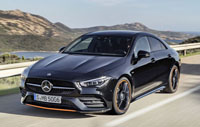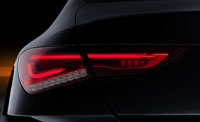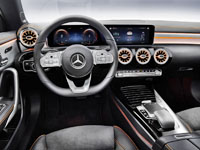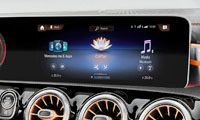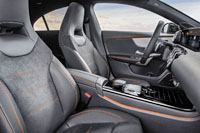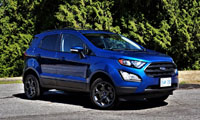
The EcoSport, that just recently entered the Canadian market for the 2018 model year, will soon be the oldest SUV in Ford’s burgeoning lineup. This is due to the mid-size seven-passenger Flex fading into the sunset when its remaining 2019 model run gets sold off. Where the Flex was one of the blue-oval brand’s largest crossover SUVs, the EcoSport is by far its smallest, and therefore fills Ford’s critical gateway position now that the subcompact Fiesta hatchback has also been discontinued from the North American markets.
Of note, Ford’s other crossovers and SUVs have been more recently refreshed or redesigned, the former car-based models including the completely redesigned 2020 Escape, the recently refreshed Edge that came out for the 2019 model year, and the entirely redone 2020 Explorer that’s just arriving now, whereas the not quite as new truck-based Expedition SUV will soon be second oldest.
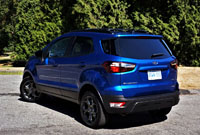
Soon Ford will add two new models to its utility lineup, the first being the impressive but oddly named Mustang Mach-E (I hope they drop the “Mustang” part and just call it the “Mach-E”), sized between the Escape and Edge and powered by a new plug-in electric drivetrain, and the second an even more interesting (to me at least) compact truck-based body-on-frame 4×4 that brings back the classic Bronco name. A smaller “baby Bronco” is reportedly planned to go up against the subcompact Jeep Renegade, just like the new Bronco will go head-to-head with the iconic Jeep Wrangler 4×4, which means off-road fans will soon have a lot more to get excited about.
Ford will continue to dominate the truck market with its best-selling F-Series, of course, and do its best to make the new (to us) Ranger mid-size pickup as popular as its slightly smaller predecessor used to be, while it will probably maintain its leadership in the commercial van segment as well, its Euro-style Transit full-size van well ahead of all rivals on the sales charts. Ford still makes the classic Econoline, by the way, but it’s only available with a cutaway chassis cab body in our market, plus the Transit Connect does very well in the smaller compact commercial van category.
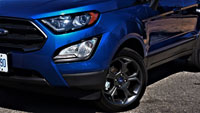
Now that I’ve come this far I might as well finish off with every blue-oval model available to Ford’s Canadian customers, the fabulous GT super car still showing on the brand’s retail website despite being sold out some time ago, and the Mustang still North America’s go-to sports/muscle car by a long shot, while the Fusion mid-size sedan will be with us for one last year before being sent out to pasture like the larger Taurus full-size sedan, the little Fiesta subcompact, and the compact Focus (plus sadly the later two models’ superb ST and RS performance versions, and the once great SHO).
Until Ford comes out with an ST version of the EcoSport I can’t see enthusiasts getting excited about it (hey, they brought us an Edge ST, so you never know), but it look good and drives well for such an old SUV, plus it offers up a nice assortment of features and can be had for an even more compelling price. This current second-generation EcoSport arrived in other markets during 2012 as a 2013 model, which adds up to six years before it arrived as an all-new model here in North America. I first saw the original EcoSport (a design I really liked at the time) when I was living in São Paulo, Brazil, and now that I’m more often on the other side of the world in Metro Manila, Philippines, I’ve been seeing this new one becoming popular there for about six years (and likewise for our all-new Ranger pickup that was been a big seller there since it hit the market in 2011).

Like the Ranger, the EcoSport has aged quite well. It wears Ford’s most older grille design, last seen on the 2019 Escape and 2018 Edge, so it doesn’t look out of date unless you see it lined up in row of its blue-oval contemporaries. A redesigned third-generation EcoSport should be out by 2021 as a 2022 model, so at least we can be fairly certain this 2019 version, and the mostly unchanged 2020 version, won’t be redesigned for couple of years or more.
As it is, despite its age the EcoSport has plenty of redeeming qualities, the first being decent fuel economy due to standard auto start-stop technology that shuts the engine off when it would otherwise be idling in order to reduce fuel usage and improve emissions, all before restarting automatically when letting off the brake.
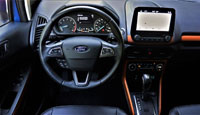
This EcoSport comes standard with the same turbocharged 1.0-litre three-cylinder that I first enjoyed in the Fiesta. While a fun-to-drive entry-level engine, it’s also capable of an 8.6 L/100km city, 8.1 highway and 8.4 combined Transport Canada rating, while the even stronger 2.0-litre four-cylinder I tested here is good enough for an estimated 10.2 city, 8.0 highway and 9.3 combined. To be clear, this is fairly thrifty when compared to some of its key rivals, and falls short of others, finding a happy medium right in the middle.
The middle-of-the-road EcoSport story is similar for pricing too, with the base 2019 S model starting at $22,349 (plus delivering and other fees), and fancier trims including the SE at $25,449, SES at $29,849 and top-line at 31,349. All-wheel drive can be added to S and SE trims for $2,500, while it comes standard in the SES and Titanium. Notably, the pricing just quoted was heavily discounted at the time of writing, with CarCostCanada reporting additional incentives up to $4,500 on this 2019 EcoSport, or for those wanting the newer 2020 model, factory leasing and financing rates from 3.99 percent. Go to the 2019 or 2020 Ford EcoSport Canada Prices page right here at CarCostCanada for all the details, plus the ability to price and configure EcoSport models, while accessing available manufacturer rebates, dealer invoice pricing that could save you thousands, and much more.
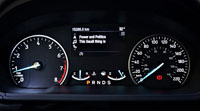
Of course, selling on price is not a good way to make a profit, but that’s Ford’s problem. Still, as noted earlier there’s a lot more to like about this little SUV than its reasonably low fuel economy and attractive pricing. Both direct-injected engines provide pretty strong performance, actually, the base turbocharged 1.0-litre three-banger good for 123 horsepower and 125 lb-ft of torque, and the as-tested naturally aspirated 2.0-litre four making a more spirited 166 horsepower and 149 lb-ft of torque.
Additionally, neither engine is held back by the vague performance of a continuously variable transmission (CVT) or a slow-shifting regular automatic, but instead get Ford’s well-proven six-speed SelectShift dual-clutch automated manual. It may not be the most dependable transmission ever made, but it delivers very quick, snappy shifts, enhanced with steering wheel-mounted paddle shifters in SES trim, along with the same ease-of-use the two less exciting transmissions provide.
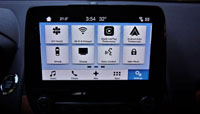
Underpinning the entire SUV is a fully independent suspension featuring MacPherson struts in front and a multilink setup in the rear, plus a stabilizer bar at each end. Additionally, twin-tube hydraulic gas-pressurized shocks keep the front wheels connected to tarmac while progressive-rate springs with mono-tube hydraulic gas-pressurized shocks lock in the back end, while a fairly direct feeling electric power steering system makes manoeuvring the EcoSport into tiny parking spaces easy and negotiating heavy traffic a breeze. Ford’s smallest SUV feels nice and stable through slaloming roadways too, and tracks well on the open highway. No matter the conditions it’s a fun little utility to drive, even on slippery surfaces where Ford’s AdvanceTrac traction control with RSC (Roll Stability Control) keeps it under control, and the SUV’s standard four-wheel discs with ABS provide good braking performance.
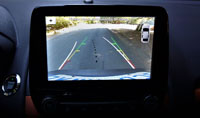
The way this EcoSport drives makes it easy to understand why 7,438 Canadians bought one last year (which is a bit less than mid-pack, with six subcompact crossover SUVs selling fewer and 10 delivering more), but just the same I could see why some may have chosen it because of styling first and foremost. My SES example was painted in an eye-catching Lightning Blue with sporty black accents all around (although it didn’t wear this trim’s optional black decals on the hood and rooftop), some of its best design details being the Dark Tarnish Metallic-painted 17-inch rims it rolled on.
The interior, however, was colour-matched by the three blind mice. Who decided that its mostly Ebony Black cabin colour (shade) scheme should be accented with copper-orange on every model? I suppose blue and orange don’t completely clash (a similar livery kind of worked for McLaren F1 this year), and of course it’s perfect when choosing the EcoSport’s available Canyon Ridge (copper) exterior paint, but I’m glad Ford recently decided to ditch this unusual colour combo for trusty old grey. As it was, my tester’s partial leather seat upholstery included copper orange stripes on their stain-resistant ActiveX fabric inserts, these matching the same copper highlights that run across the instrument panel, on each side of the console, and along the door panels.
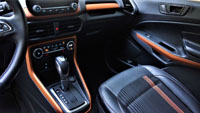
All said, I can’t see anyone complaining about the SES model’s aforementioned 17-inch alloy wheels or its sport-tuned suspension upgrade, or for that matter the paddle shifters I commented on a while ago. Other niceties with this trim include rain-sensing windshield wipers, an auto-dimming centre mirror, blindspot monitoring, an 8.0-inch infotainment touchscreen with Ford’s best Sync 3 interface, a navigation system that worked perfectly during my test week, a pretty good seven-speaker audio system, and a very useful household-style 110-volt power outlet.
Sync 3 infotainment is still very good despite not being as recently updated as some competitive systems. Along with than the items already mentioned, its feature set includes the expected tablet-like tap, swipe and pinch gesture controls, Apple CarPlay and Android Auto smartphone integration, easy Bluetooth connectivity for your phone and audio streaming, voice activation, a 4G LTE Wi-Fi hotspot, plus the ability to play AM, FM and satellite radio stations, of course. Satellite in mind, Sirius Travel Link is also included, plus a number of apps, while the Sync 3’s graphics are organized into convenient tiles in an attractive white on sky blue colour scheme. It’s not new, but it’s still very good.
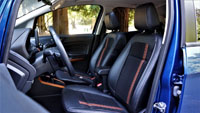
Missing from my SES tester was dual-zone automatic climate control, but its single-zone auto HVAC system was plenty good for my needs and as good as this entry-level SUV segment usually gets, while its front seats were only four-way manually adjustable, which was another inconvenience that didn’t matter much to me. The seats were comfortable and supportive just the same, plus my long-legged, shorter torso five-foot-eight frame fit well due to better-than-average reach from the EcoSport’s tilt and telescopic steering column.
It’s spacious as well, and especially good for taller occupants. In fact, both the front and back seating areas are well proportioned, but I recommend leaving the rear centre position unoccupied when four adults are aboard. The cargo compartment is fairly large too, with 592 litres of volume behind the 60/40-split back seats and 1,415 litres when lowered, although the load floor doesn’t lay very flat.
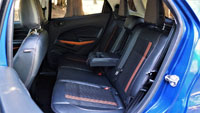
Accessing the cargo compartment comes via a side-swinging rear door that might be a deal-killer for some. Not only did it squeak while driving (or at least something near the door was squeaking annoyingly all week long), but who wants to deal with a heavy, inconvenient side-swinging rear door when there’s 16 competitors (and three more on the way) that offer a liftgate that also acts as a shelter in the rain? At least it opens on the proper side for North American markets, unlike some others (Jeep) that make it really difficult to load from the curb, not to mention dangerous if forced to step into the line of traffic with arms loaded. It opens easily enough thanks to gas struts, but you’ll need to make sure and leave plenty of space behind the EcoSport for the wide door to swing it out when parked on the side of the road, while if another driver (parker) parks too close, good luck getting anything into the back (not usually a problem with a liftgate).
As for interior finishings, it’s better than some and not as good as this segment’s best sellers due to an abundance of hard plastic surfaces. I know this is a base subcompact and buyers in this class aren’t expecting Range Rover detailing, but some in this category are delivering a more premium experience than others, and therefore merely adding a pliable composite dash top/instrument panel along with padded armrests isn’t enough these days.
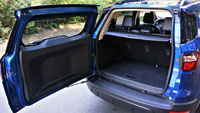
As my regular readers know, I don’t hold back when I don’t like a vehicle, but I think I’ve been very fair with Ford’s EcoSport. It’s one of the oldest SUVs in this class, yet it does a pretty decent job of looking good, plus it balances a really fun driving experience with reasonable fuel economy, it’s plenty comfortable, very spacious, is equipped well enough, has a great infotainment system (and has an attractive set of gauges with cool blue needles), and (squeaking and side-swinging rear door aside) is quite practical. The fact you can currently save thousands on a new 2019 is a major bonus that should be considered too, so if you can live with its few shortcomings (and most rivals could be better too) the EcoSport is worth a closer look.
Story and photo credits: Trevor Hofmann

